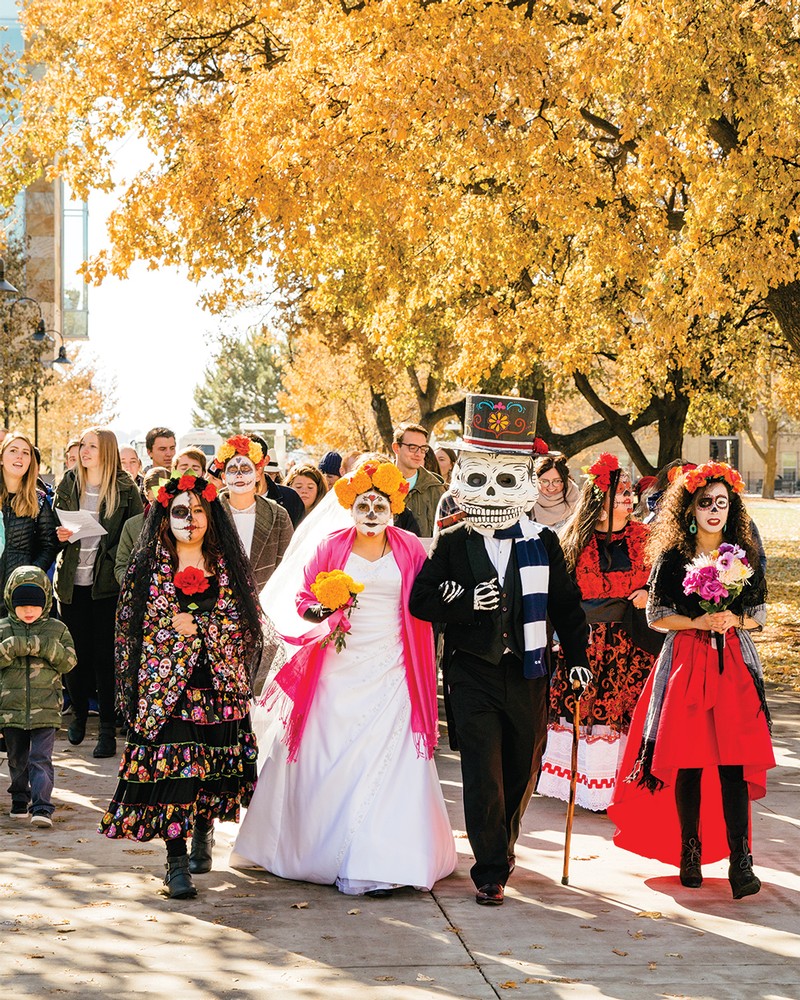Providing a safe space at USU through cultural traditions
Students and community members dressed in traditional attire complete with painted faces and bright marigolds flooded Utah State University campus on Nov. 2.
Music followed the large group as they progressed through a cloudy, water-logged campus. Children and parents trailed behind, marveling at the decorated dresses, intricate masks,and the uniform sound of dozens of boots hitting pavement.
The procession honored Dia de los Muertos, a holiday celebrated Nov. 1-2 by several Latin American countries.
The holiday, also known as Day of the Dead, originated 3,000 years ago with the Aztec ritual “Miccaihuitl.” The tradition, although based on death, is completely unrelated to Halloween.
Dia de los Muertos provides relatives the opportunity to demonstrate love and respect for their dead ancestors through a variety of traditions. This year, USU held several events celebrating the holiday, honoring a tradition that holds a special place in the hearts of many students and faculty at the university.
According to Maria Spicer-Escalante, a professor of Spanish at USU, there are three components to the holiday: preparations at home, a parade in the streets — like the procession around USU’s campus — and celebrations in the cemetery.
At USU, this included the procession, a large ofrenda set up in the Taggart Student Center and an exhibit at the Nora Eccles Harrison Museum of Art, among others.
Many families honor their ancestors at home by building what’s called an ofrenda: often a tiered table where people place pictures of their dead ancestors, food, candles and other decorations.
The ofrenda helps participants remember and honor their passed loved ones. Escalante’s personal ofrendas have helped her honor the dead throughout the years.
After 9/11, she used her ofrenda to remember those who had died during the catastrophic event.
“I put the food and flowers, the bread, the beverages,” she said. “The last thing that you do is to light the candles and when I lit the candles, I was thinking of them.”
Last week, students from South Cache Middle School filed into the Nora Eccles Harrison Museum of Art to marvel at a traditional ofrenda and learn more about the Latin American holiday.
The ofrenda, set up in the museum’s entrance, stood out against the building’s cool colors with a bright yellow and red tablecloth. Offerings ranging from tamales, pastries and pictures of famous Latinx people stretched across the table.
Paper “calaveras” — pictures of traditional skulls used to decorate for the holiday — colored by students from another school, American Heritage, pasted the glass walls of the museum.
“They went right there to see and to recognize the Calaveras,” Escalante said. “I’ve seen some parents and chaperones with them happy that their kids are proud of this tradition.”
This is the exhibit’s second year at the museum. The museum’s director invited Escalante to create the exhibit after overhearing her talk about the holiday. Escalante seeks to share a tradition close to her heart with the community through the ofrenda.
“The main thing was to share my tradition, to share my tradition and to give a space for people to think of their loved ones,” Escalante said.
This year, the exhibit was displayed Nov. 2-15.
The exhibit at the museum highlights the importance of celebrating a variety of cultural traditions and holidays.
“Sometimes you can feel like left out or feel like not accepted, like not worthy,” said Shari Linares, the social chair for USU’s chapter of Latinos in Action. “Especially if you don’t see yourself, if you don’t see the cultures and the things that you’re doing celebrated at the university that you’re at.”
Linares planned a dance on Nov. 5 to celebrate Dia de los Muertos. The dance included refreshments, a photo booth and music from various Latin American countries.
“I was super super happy with how it turned out,” Linares said. “Everyone was having a lot of fun — enjoying themselves — got to meet new people and have a little bit of outreach within the community as well.”
Through events such as the dance, Linares hopes to create a safe space for other people of color.
“My goal mostly within Latinos in Action is to have outreach and to provide those safe spaces for people of color to enjoy themselves and feel accepted and feel loved and feel welcome to the university,” she said.
Although Linares wasn’t able to attend any of the other celebrations at USU for Dia de los Muertos, she did visit the ofrenda exhibit at the art museum last year. Linares said she hopes USU will continue to provide safe spaces for people of color and other minorities to thrive and feel comfortable expressing their culture.

